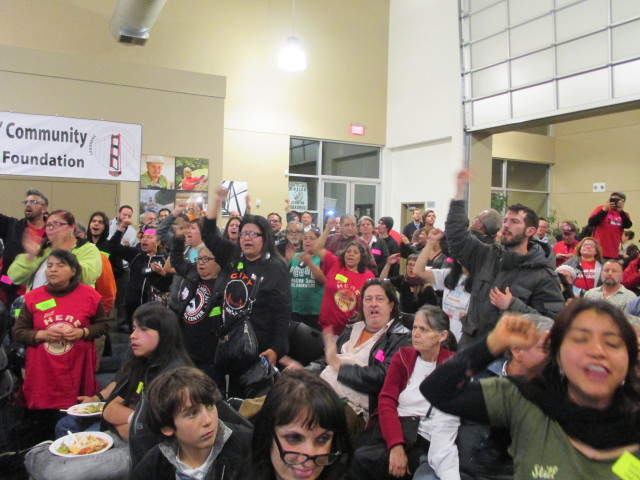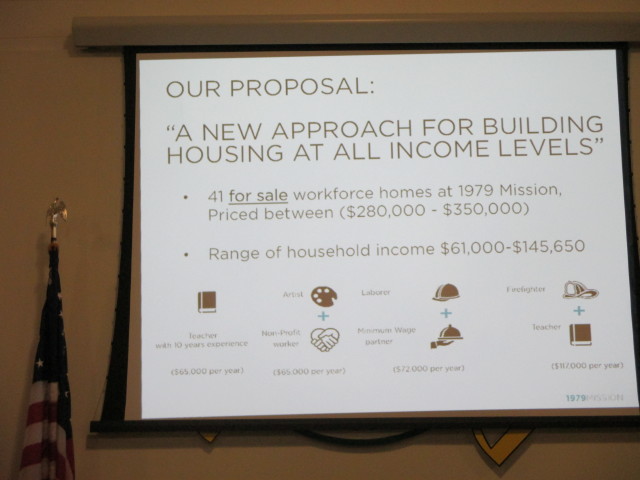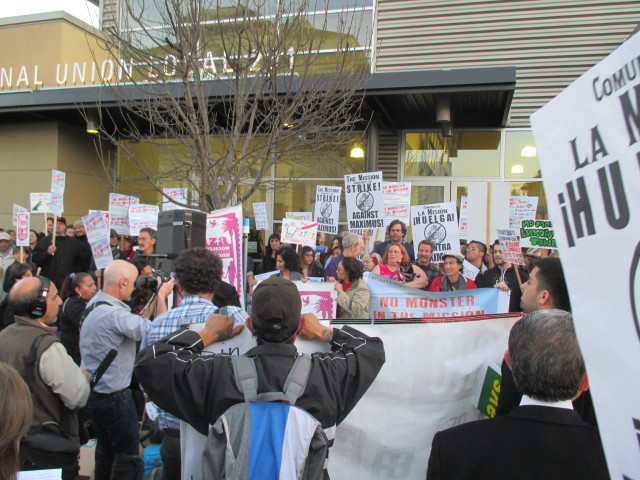More than 300 people pack community meeting to oppose 16th and Mission project

By Tim Redmond
MARCH 4, 2105 – Seth Mallen, executive vice president of Maximus LLC, managed to get about three minutes into his presentation tonight before the crowd erupted.
“Mic check”
“Mic check.”
The crowd of maybe 350 people was listening to someone else.
“We know about your broken promises,” Maria Zamudio, of Causa Justa: :Just Cause, announced. “We don’t want you here.”
The room broke into cheers.
This wasn’t exactly what the giant real-estate developer had in mind when it set up a community meeting to present what it described as a community benefits package for the 16th and Mission housing development.
Mallen and Larry Del Carlo, who is working with the developer, asked the community activists to listen to what they had to say. “It’s important for people to hear our proposal,” the company’s spokesperson, Joe Arellano, told me earlier.
But the proposal was already out – it appeared in the Chronicle earlier this morning – and the broad-based coalition called Plaza16 wanted none of it.
The Maximus plan calls for 290 market-rate rental units and 41 “workforce housing” condos, priced at between $280,000 and $350,000. The company will also pay to finance 49 below-market units, which won’t be on site and might not be in the Mission.
The way the city’s affordable-housing mandate works, developers can pay into a fund that goes for low-income units – but that money will go into a pot that will later finance what will likely be larger project, somewhere in the city, at some point in the future.
The “workforce” units will be available for households with incomes from $60,000 to about $130,000, and Maximus had a nifty chart that showed who that might be. For example, an “artist” and a “nonprofit worker” could make enough money together to buy one of the low-end condos, which Arellano told me would most likely be a studio.

Two city employees at the upper end of the scale – say, in public safety – could buy one of the two-bedroom units.
Combined with the below-market units which won’t be built at the same time as the 16th and Mission project, the deal includes 31 percent “affordable” housing, Arellano told me.
The below-market units, 49 out of a total of 350 units, amounts to about 14 percent, just about what the city requires from developers anyway.
There was talk of an improved BART plaza (“a plaza for everyone”) that will be larger and “safer.” That means, many fear, that the people who live in Mission SROs who hang out at the plaza to be outside during the day, and the homeless people who spend time there, will be driven out by a more aggressive law-enforcement presence.
Every time Mallen or Del Carlo tried to speak, and present the company’s plan, they faced a festive, vocal audience that had one clear demand: The community groups want 100 percent affordable housing on the site.
That, of course, won’t work with what Maximus wants to do, as Bert Polacci, a senior partner in the lobbying firm Public Advocacy Partners, tried to explain to several activists after the meeting. Maximus is a business, and there’s no way to build 100 percent affordable housing as a private, for-profit venture.
One person asked him why apartments had to be so expensive if developers are building much cheaper rentals all over the country. “This is San Francisco,” where land and construction is expensive, he said. I asked him if he would make public the company’s finances, so we could see what the figures are and whether lower-cost housing might pencil out.
“Of course not,” he said. “This is a private venture.”

There were two factors that drove this protest, and will drive a long future battle against this project, factors that the developers need to understand.
One is the deep-seated and growing anger over the evictions, the displacement, and the destruction of the Mission community. It’s not easy to get 350 people out for an event like this – and they weren’t all (or even mostly) young activists. The crowd was multilingual, diverse in ages – and reflective of the seething fury that is now part of the culture of the neighborhood.
The city has done very little to prevent working-class people from being driven out and replaced with higher-income workers, many of them in the tech business. Small businesses are getting displaced as rents rise.
That may not be the fault of Maximus – but the company has connections at City Hall, and probably in Sacramento, and there’s a lesson here. If developers want to build like this in San Francisco, first they have to help stabilize the existing vulnerable communities. First the evictions and displacement has to stop; then people will talk about new development.
The speculators who are taking advantage of the housing market to make millions flipping property are not only forcing people out of their communities; they are creating so much anger and distrust that nothing is going to move forward without serious opposition until the people who live here and operate businesses here now stop waking up every morning wondering if they will be displaced tomorrow.
The other element in the refusal among many San Francisco residents to accept the idea that more market-rate housing in low-income communities will help the crisis. In fact, there’s a lot of evidence to the contrary: If this project is built at 16th and Mission, real-estate values will rise in the surrounding area. Commercial spaces that have been cheap for years will suddenly be gold mines. Marginal businesses that serve a low-income population will be replaced with services for the wealthier residents who will move in.
We can argue forever about whether supply and demand works in the San Francisco housing market. There is no economist with any sense who would argue that bringing a large number of higher-income residents to an area like 16th and Mission won’t drive up commercial rents and change the mix of local businesses.
Just look at Valencia Street.
The message that was delivered tonight was simple: The community doesn’t want this project. And it’s going to be a long, tough fight for Maximus to get it approved.
Let me just say one more thing about how development works in San Francisco.
Market-rate housing is a very lucrative investment right now. That’s why lots of international capital goes into high-end housing in the city. Developers and investors are making big returns.
Every project sponsor comes forward with a plan that offers a certain level of community benefits. The more pressure they get, the more they offer. When projects are shut down altogether – when developers realize, for example, that no project at 16th and Mission in 2015 is going to go forward with the normal return on investment and profit that’s expected from market-rate housing in the city – it sends a message.
I don’t know if there’s any commercial housing project that the community will accept today at 16th and Mission. But I can say that what we saw tonight was a first offer, and it was soundly rejected.



